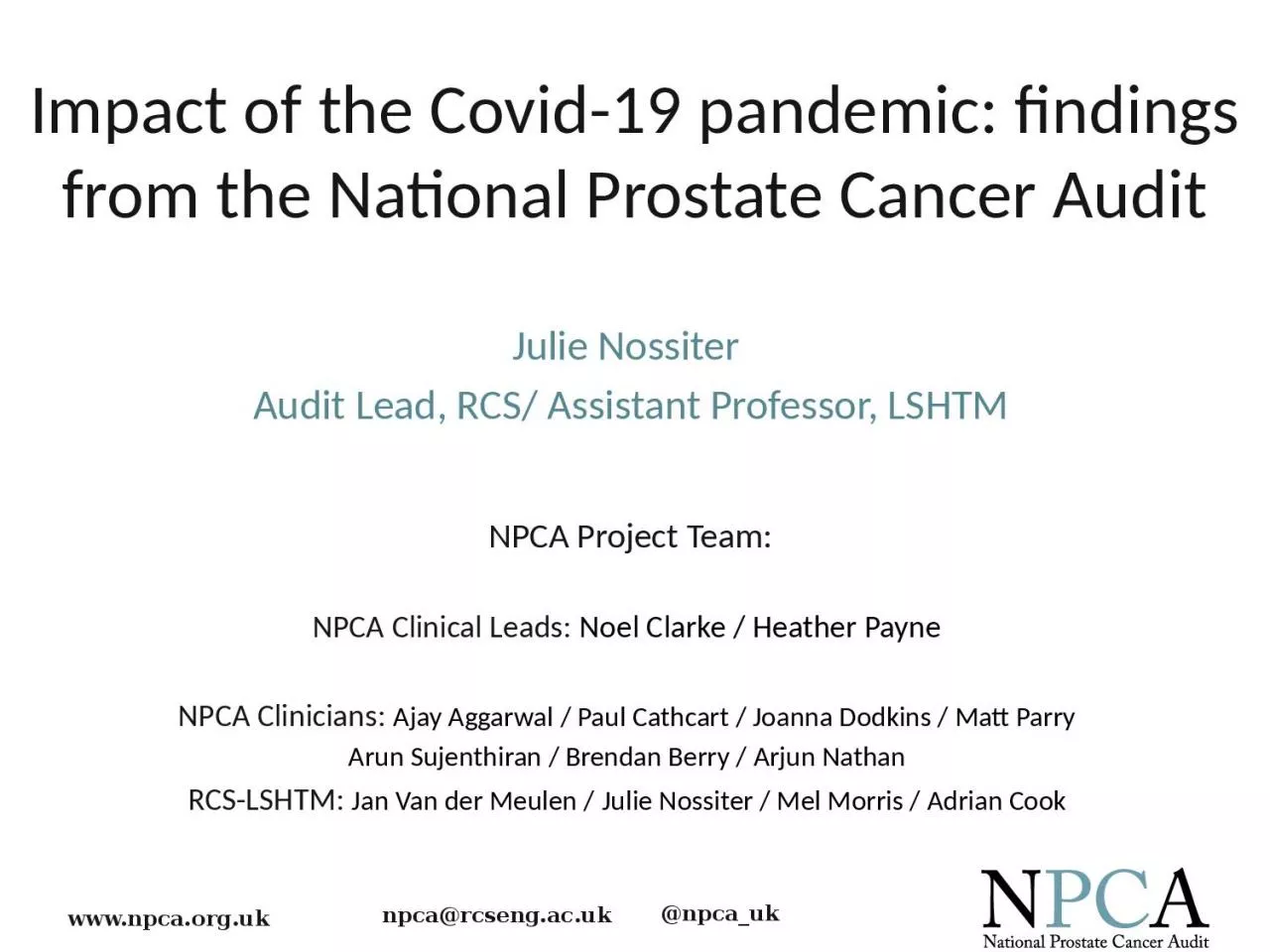

Commissioned by HQIP on behalf of NHS England and Welsh Government Based at the Clinical Effectiveness Unit Royal College of Surgeons London School of Hygiene amp Tropical Medicine ID: 1041353
Download Presentation The PPT/PDF document "Impact of the Covid-19 pandemic: finding..." is the property of its rightful owner. Permission is granted to download and print the materials on this web site for personal, non-commercial use only, and to display it on your personal computer provided you do not modify the materials and that you retain all copyright notices contained in the materials. By downloading content from our website, you accept the terms of this agreement.
1. Impact of the Covid-19 pandemic: findings from the National Prostate Cancer AuditCommissioned by HQIP on behalf of NHS England and Welsh GovernmentBased at the Clinical Effectiveness Unit, Royal College of Surgeons / London School of Hygiene & Tropical MedicineClinical leadership provided by BAUS and BUGData partners: National Cancer Registry and Analysis Service, Wales Cancer Network
2. Impact of the Covid-19 pandemic: findings from the National Prostate Cancer AuditNPCA Project Team:NPCA Clinical Leads: Noel Clarke / Heather Payne NPCA Clinicians: Ajay Aggarwal / Paul Cathcart / Joanna Dodkins / Matt Parry Arun Sujenthiran / Brendan Berry / Arjun Nathan RCS-LSHTM: Jan Van der Meulen / Julie Nossiter / Mel Morris / Adrian Cook Julie Nossiter Audit Lead, RCS/ Assistant Professor, LSHTM
3. Diagnosis and treatment of men with prostate cancer during the Covid-19 pandemicEvaluate the impact on the diagnosis and treatment of men with prostate cancer (PCa) Quantify the proportion of the ‘at risk’ population who have experienced delays or changes in careAims:
4. Diagnosis and treatment of men with prostate cancer during the Covid-19 pandemicDiagnostic and treatment activity was determined across all NHS hospital providers of PCa care in England compared with the same calendar periods in 2019Considered patients to be diagnosed or treated in the initial phase of the pandemic if date of diagnosis/treatment was between 23.03.20 (start of the first lockdown) – 04.07.20 (restrictions eased) Methods:
5. Prostate cancer diagnoses48.3% reduction (6,247 vs 12,066) in the number of men newly diagnosed during the first lockdown in 2020 compared with the corresponding period in 2019
6. Prostate cancer diagnosesOverall, 30.8% reduction (22,419 vs 32,409) in the number of men newly diagnosed after the start of the first lockdown to the end of 2020 compared with 2019
7. Prostate cancer diagnosesMen were more likely to be diagnosed at a more advanced stage (21.2% vs 17.4%, stage IV; 2020 vs 2019) and were slightly older (57.9% vs 55.9% ≥ 70 years, p<0.001)
8. Prostate biopsiesCorresponding reduction in the number of prostate biopsies performed
9. Prostate biopsiesMore often performed through the transperineal (TP) vs transrectal (TR) route after the start of the first lockdown in 2020 compared with the corresponding period in 2019 (TP vs TR, 64.0% vs 38.2%)Transperineal biopsies (%)
10. Surgery (radical prostatectomy, RP)46.3% reduction (1,076 vs 2,005) in the number undergoing RP during the first lockdown compared with the same calendar period in 2019
11. Surgery (radical prostatectomy, RP)Overall, 26.9% reduction (3,896 vs 5,331) in the number of men undergoing surgery
12. Surgery (radical prostatectomy, RP)Cancer stage in men undergoing RP was less advanced than those in 2019 (34.8%% vs 39.6%, stage 3; 2020 vs 2019)
13. Radiotherapy (radical EBRT)45.4% reduction (2,339 vs 4,287) in the number undergoing EBRT during the first lockdown compared with the same calendar period in 2019
14. Radiotherapy (radical EBRT)Overall, 14.1% reduction (9,719 vs 11,309) in the number of men undergoing EBRT
15. Radiotherapy (radical EBRT)Other changes included an increased use of a hypofractionation (83.1% vs 78.1%) compared with 2019
16. Systemic treatment: hormone-sensitive PCaRapid and marked fall (72.8% reduction) in the use of docetaxel after the start of the first lockdown in 2020 compared with the corresponding period in 2019 (413 vs 1,519)
17. Systemic treatment: hormone-sensitive PCaMarked increase in the use of enzalutamide in men with hormone-sensitive PCa compared with 2019 (5 vs 1,040)
18. ConclusionsAlthough diagnostic and treatment activity rapidly increased after the end of the first national lockdown >> ongoing deficits by December 2020 Deficit(23rd Mar to 31st Dec)% reduction (2020 vs 2019)Diagnoses9,99030.8Radical prostatectomy 1,43526.9Radical radiotherapy 1,59014.1Significant additional capacity to address this backlog
19. ConclusionsCare changed and shift towards patterns that limit the risk of Covid-19 exposure for patients during treatmentaccelerated uptake of transperineal biopsiesincreased the use of hypofractionationsubstitution of docetaxel >> enzalutamide
20. Next steps for the NPCAReport on the variation by region and cancer alliance >> Annual Report published 13.01.22Determine the impact of changes in diagnostic and treatment pathways during 2020 on patient outcomes >> impact of delaying RP in high-risk disease +/- ADTExplore the impact of subsequent phases of the pandemic and ongoing measures to reduce transmission during 2021 on the recovery of PCa services
21. Thank you!Please post your questions for discussion by the panel in the Q&A box
22. Prostate biopsiesMore often performed through the transperineal route after the start of the first lockdown in 2020 compared with the corresponding period in 2019 (TP vs TR, 64.0% vs 38.2%)